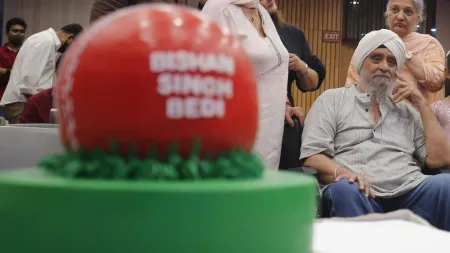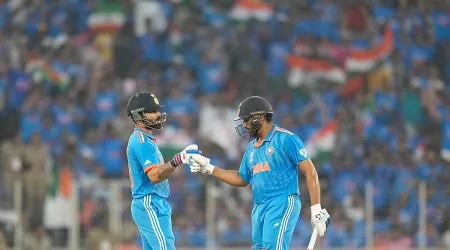- India
- International
IPL 7: Turning up late
Shane Watson, at ease with both bat and ball, discusses the tricks of the trade with Bharat Sundaresan.
Armed with the most potent yorker in the game, Lasith Malinga has justifiably created a reputation of being the Grim Reaper of opposition batsmen in T20 cricket. Still, when you think death overs, it’s not the slinging Sri Lankan and his toe-crushers that come to mind first. Instead it’s the sight of muscular batsmen, and even brawnier bats, smashing balls into orbit.
But the bowlers, led by Malinga and his unglamorous ally Nuwan Kulasekara, ensured that they got their own back during the World T20 in Bangladesh. At times, the bowlers even ended up with bragging rights, like in the final where Malinga and Kulasekara kept India down to 19 runs off the last 27 balls. And also that time when Dale Steyn managed to stall New Zealand with just seven required off the final over.
Over the next month and a half, it will be the death overs again that will dominate pre-match discussions and team meetings as IPL-7 gets going. For, more often than not, it’s this hectic and thrill-a-minute period of play that decides the outcome of a T20 contest.
Shane Watson, for one, has shouldered the responsibility of shepherding his team manfully in this pivotal period with both bat and ball for the Rajasthan Royals, throughout the history of the IPL. And in an interview with The Sunday Express, the Royals skipper explains the multitude of challenges that bowlers and batsmen have to contend with in the death overs of a T20 contest. The Australian all-rounder, however, also offers a pragmatic admission, insisting that you can plan all you want but there can never exist a fool-proof strategy of escaping the inevitable onslaught. Excerpts.
Do you think the bowlers have held their own during the World T20 in Bangladesh?
There’s always going to be times when bowlers do get the upper hand. The conditions in Bangladesh certainly were more conducive to bowling, especially spin bowling. Certain spinners like Saeed Ajmal, Sunil Narine and Samuel Badree did a great job for their teams, so did Ravichandran Ashwin for India. There’s no doubt that bowlers are always learning and trying to find ways to limit the damage. The bowlers had their way in the World T20, but history tells us that the IPL always has more high-scoring matches.

Do you think the death-over performance by Malinga and Kulasekara during the World T20 final was among the best ever?
To be able to hold the Indian team with their dynamic batting line-up to just 19 runs in the last 5 overs is an incredible performance. That too, to do that under pressure in a final against the likes of Virat Kohli and Yuvraj Singh, and the likes of MS Dhoni and Ravindra Jadeja in the dug-out, is phenomenal. That is where they won the game.
Malinga has always been the best death bowler in the world throughout the history of T20 cricket, so under pressure you certainly know what he’s going to produce. Kulasekara, meanwhile, is as good even if he might not be as eye-catching.
How difficult is it to execute the wide yorker as consistently as the two Sri Lankans did in the final? Does it in a way neutralise the nature of the pitch and conditions?
The yorker in general is very difficult to execute, let alone pinpointing the line that you want to bowl it. The wide yorker adds another dimension because you’ve got to get the line right and not bowl a wide. But it’s something that you have to practise a lot. It certainly does neutralise pitch and conditions. If you are able to execute a yorker every single ball, the batsman’s not going to be able to score too many runs because the middle is not at the bottom of your bat. You’ve got no power while hitting the ball with the bottom of your bat. Malinga is somebody who’s able to bowl yorkers at will when he’s bowling well, which is a majority of the time. But it’s not as easy to do for mere mortals. Even some world-class bowlers have struggled.
Is the wide yorker the best ploy? And as a batsman how difficult is it to cope with?
There’s couple of theories of what the best ball is. There’s no doubt a wide yorker, if executed right, is very difficult to play. You can’t hit it for six on most occasions. But there’s also another school of thought. Somebody like Dwayne Bravo comes in around the wicket and bowls a yorker to a right-hander’s leg stump, cramping him and cutting down the batsman’s power zones. The wide yorker has stood the test of time but the Bravo way can be a clever ploy too.
How would I deal with it? Well, most of the time if I know somebody’s going to bowl wide yorkers, I’m going to move across my stumps to try and put pressure on the line that they are targeting. It makes it tough to get any elevation on the ball or a lot of power for that matter. But if they don’t get it right, it’s either a wide or it’s right in my swinging zone, allowing me to get a good bat-swing at it.
Kevin Pietersen recently spoke about how a bowler needs to have at least three to four plans each time he runs in with the ball in the death overs…
Yes, absolutely. You also need to be able to have a specific field which means that you can bowl at least three balls to that same field. That keeps the batsmen guessing. He doesn’t know whether it’s going to be an attempted yorker every ball. You need to be able to have options to bowl different balls. When the field is set where only one ball can be bowled, and if you don’t get it perfectly right, which happens most of the time, it’s going to be very difficult to stop a batsman.
There are some batsmen who don’t give much away till the ball is released. What is your plan against them when you’re bowling?
Your plan doesn’t change. Going into a game, you are always going to know the batsmen’s strengths and weaknesses. Some guys move, some guys don’t. So, you’re always going to stick to your plans. What you need to do is not get too affected by this movement.
So will someone like Virat Kohli be among the toughest batsman to bowl at considering he makes his move only after the ball has left the bowler’s hand?
I think Virat Kohli in general is the most difficult batsmen to bowl to. He’s in incredible touch at the moment. He has been for a few years now. So, no matter where you bowl, he can hit the ball to anywhere around the ground. There’s no batsman in the world today who’s got the range like Virat does. Majority of the time, you know which way he is going to hit or which are his strongest zones, but it’s still difficult to stop him. Often, a captain has no clue where to set a field to him. Because when he’s going, he’s flying, there haven’t been too many bowlers in the world who can restrict him.
How much can you learn about a batsman’s intentions by watching his feet? Is that a crucial tactic for a bowler in the death?
Certainly, for me it is the most important aspect when you’re bowling in the death, to be able to follow a batsman’s feet and know where they are moving. And then, at the last moment, to be able to react to where they move to. Because if they move in a certain direction and if you don’t respond to it, you will be bowling exactly where he wants you to bowl.
How often do you use change of pace or even the low full-toss in the death overs?
Not too much. It’s more about just following their feet and adjust the exact line that you are trying to bowl. If it’s a wide yorker, you just have to adjust your line to try and make it even wider. Or if you’re bowling at their feet, you try to follow them and to keep it on the leg side of their feet. You’re never trying to bowl a low full toss. You are always trying to bowl a perfect yorker, sometimes, it just comes out the wrong way.
How much does hitting or getting hit for a boundary off the first two deliveries have an impact on the rest of the over?
If you get hit for a couple of boundaries in the first two balls, you are trying to do whatever you can and get done with your over without conceding too many more. The balls that you bowl then will certainly be slightly different from what your plan was originally. In T20 cricket, you are always trying to bowl the ball that the batsman isn’t expecting. So, by getting those early boundaries he’s ensuring that the bowler’s scope is reduced drastically. As a bowler you need to focus on sticking to your guns without letting him decide the areas your are targeting. Yes, even if the first two balls travel to the fence or over it.
Now as Rajasthan Royals’ captain, how do you plan to deal with your bowlers, say James Faulkner, who generally bowl in the death?
Jimmie Faulkner is certainly one of the best death bowlers in the world and he did a great job for us last year. But he also does a phenomenal job in the first six overs, getting crucial wickets. In our squad, we have a lot of high quality options to use in the first six overs and certainly in the death. Jimmie will certainly be a big part of bowling in the death like he was last year. But as a captain you can’t be predictable. You should be able to adapt to the batsman at the crease and also be able to mix-and-match, so he can’t get into the rhythm.
How much do you think a captain should interfere with the bowlers’ plans, or is it better to just give him a word of encouragement and let him go about his business
Even leading into the game, we’re always going to be very well planned and prepared about specific balls that we’re going to bowl to certain batsman, but you always have to think on your feet while you’re out there. It depends upon the situation in the game, what the bowlers are thinking. I’ve to decide how I am going to approach him, whether it’s giving him some direction and clarity or just some encouragement.
We need to trust each other implicitly. There’s no doubt that the last 5-6 overs, both while batting and bowling, are the most crucial times in a T20 game. That’s where if you are able to execute your skills well, both with bat or ball, games are won and lost. These are very specific roles. It’s the same when it comes to batting.
Someone like Brad Hodge/, who normally would bat in the top 3-4 has had an unbelievable amount of success doing that throughout his T20 career now. One of his roles is to be able to come in the back end of an innings and bat well under pressure. To get that momentum going from the word go.
Get latest updates on IPL 2024 from IPL Points Table to Teams, Schedule, Most Runs and Most Wickets along with live score updates for all matches. Also get Sports news and more cricket updates.










































